A dental injury is always an emergency, whether the tooth is broken or not. Treating the tooth as soon as possible optimises the chances of preserving it in a better working condition.
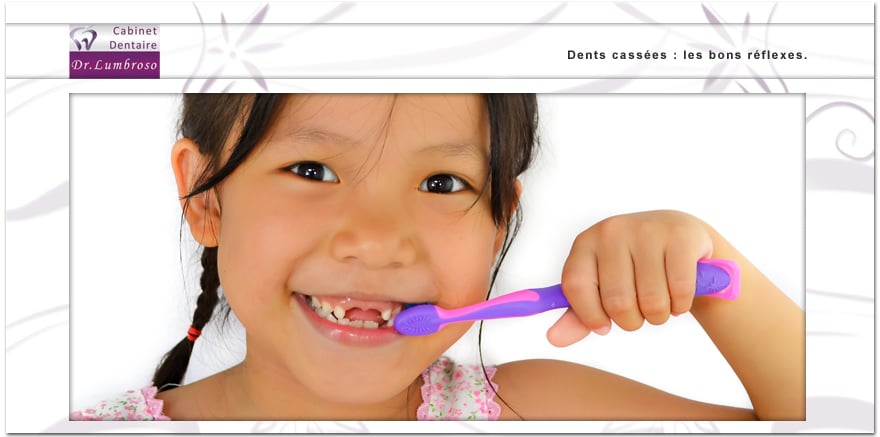
In children
This type of accident is common in children, due to the fragility of their teeth. The tooth expelled by the impact needs to be re-implanted within 20 minutes. This is a real emergency!
The root of the expelled tooth is covered with living cells that will allow the tooth to naturally re-attach to the jawbone. The vitality of these cells must therefore be preserved at all costs, and the root must be touched as little as possible.
Ideally, the tooth should be cleaned with saline solution and immediately placed back in its socket. If this is not possible, the tooth should be preserved in physiological serum or UHT sterilised milk, otherwise the tooth can be preserved in saliva, either in the mouth between the cheek and the lower molars (taking care that the child does not swallow it...), or in a small container.
It should be noted that in many countries there are "Save-A-Tooth Emergency Boxes" containing a special product (HBSS, Hank's Balanced Salt Solution), which allows an expelled tooth to be preserved for several hours.
It should be noted that the success rate of a re-implantation depends enormously on the extra-oral time and the medium of preservation.
In France, the number of re-implantations is estimated at 1500 per year.
Reacting quickly
Broken pieces of tooth should also be kept, as they can be glued back together! In certain conditions, this allows for almost instantaneous repair, especially if the fracture does not involve the pulp. Nowadays, new adhesives and composites allow the piece of tooth to be glued back together, or to reconstitute the broken part of the tooth if the piece is lost. X-rays are essential to check that neighbouring teeth have not been damaged. This will rule out a root fracture, even if the teeth do not appear to be broken. The dentist will prefer to have patients come in unannounced to treat the broken tooth as an emergency, rather than waiting until the end of the day (if the event took place in the morning), which would significantly reduce the chances of successful dental treatment.
The right reflexes
Once the tooth has been knocked out, the dentist disinfects it, then puts it back in place and restrains it with the help of a small wire held in place by composites. The reimplanted or repaired tooth can sometimes become necrotic (the pulp inside the tooth dies spontaneously) in the months following the shock. The initial treatment will then have to be completed. In order to monitor the vitality of these teeth, regular check-ups are necessary for up to two or three years after the shock in order to watch for any abnormalities. A change in colour is never a good sign.
Ultimately, dental trauma is never a trivial matter, whether it involves deciduous or permanent teeth. The expulsion or intrusion of a baby tooth can have negative consequences for the germ of a permanent tooth. If an abscess surfaces on a baby tooth that has never been treated, the germ of the permanent tooth may be damaged, leading to malformation of the permanent tooth.
Dental trauma is emerging as a public health problem as it affects a large number of children. 20% to 30% of children aged 12 years have trauma to their permanent teeth. Trauma to temporary teeth is common in pre-school children, usually as a result of learning to walk, accidents in the home or playing in the playground...
The incisors and canines of the upper jaw are the teeth most in need of dental care, as they are particularly exposed and stressed.
Risks for athletes
For certain high-risk sports (boxing, rugby, basketball, etc.), special equipment to protect the jaw and teeth is mandatory. It takes the form of a personalised mouthguard, made in the dental surgery using precise impressions.
It allows:
* the protection of the front teeth
* the prevention of damage to the back teeth, which may come into sudden contact as a result of a chin strike
* the protection of the lips, tongue and cheeks
* the prevention of brain and neck damage.
This mouthguard must comply with the standards of sports practice; it must fit easily in the mouth and be made according to the dental arches of each person, and allow normal mouth breathing.
Once again: "Prevention is better than cure!!!"
Dr Michaël LUMBROSO
Implant dentist / Periodontologist in Versailles
Dentists are increasingly pointing out to their patients the risks that a labret piercing presents to their oral hygiene. This new trend, not without consequence, requires a meticulous and very precise installation.
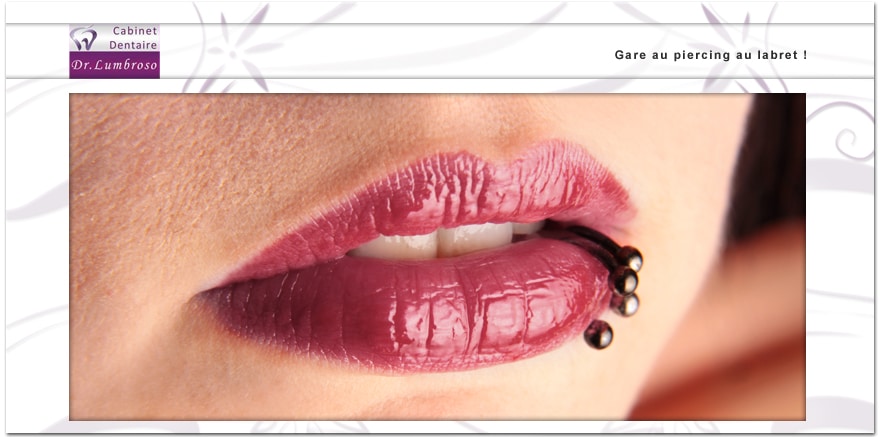
Being the first witnesses of many complications resulting from this installation, the specialists of the oral health begin to be alarmed. This piercing requires an excessively precise installation under conditions of irreproachable hygiene, this in order to limit the risks of complications such as periodontal diseases.
Risks of piercing
Complications that may be detected at the time of installation or may arise over time are
- local bacterial infections which concern 10% to 20% of piercings (streptococci, staphylococci...)
- viral infections ranging from hepatitis B, hepatitis C, herpes, HPV to AIDS
- haematomas or haemorrhages that may leave behind a large scar (due to an exaggerated proliferation and inflammation of the fibrous tissue under the skin).
In order to limit and reduce the risks to the maximum, it is necessary to show a perfect hygiene at the time of the installation of the piercing in particular by the use of sterile material with single use, the sterilization of the room and the material, the port of gloves... The people wishing to make itself a piercing must feel free to inform itself on this hygiene by visiting the buildings and by asking for more information on the methods of the installation. To avoid allergies, care should be taken to avoid travelling piercers, and check that the jewellery is made of surgical steel or gold. During the healing process, it is necessary to watch out for any abnormalities and to consult a doctor in case of doubt. Swimming in the sea or in a swimming pool is also not recommended.
Singular dangers
The labret piercing is located on the lower or upper lip. Currently this fashion is very widespread among young people, surely inspired by the many stars who have worn it.
This trend carries too many risks, noted by the medical community of dental care (composed of dermatologists, dental surgeons, orthodontists, stomatologists and maxillofacial surgeons). The labret causes all these complications because of its singular situation inside the mouth.
Beyond the immediate complications that can cause the installation of this piercing such as the infectious risks or the allergies of contact, it is also illustrated as the cause of problems often undetectable by its carrier because they are not visible, nor painful in the everyday life.
Indeed, the incessant rubbing of the labret against the teeth and the gum causes irreversible effects. The damage to the teeth and gums can be devastating: cracks, loss of enamel, dental fractures, gum recession, bone loss, loosening of teeth, etc.
Essential medical information
Before the installation of the intra-oral or buccal piercings, a medical information must be transmitted by the piercer to the customer: information on the risks and the contra-indications, possible prescription of an antibioprophylaxis, local anaesthesia and assumption of responsibility of the frequent immediate complications. The installation of approved piercings must be in adequacy with certain fixed rules such as the size and the shape (bar of small size), the nature of the material (light)... in order to improve on the long term the dento-alveolar tolerance.
It is moreover strongly recommended to address itself to a dentist before the installation of the piercing, in order to detect any anomaly, or factor of risk being able to complicate or to contra-indicate the installation.
Dr Michaël LUMBROSO
Implantologist Dentist / Parodontologist in Versailles
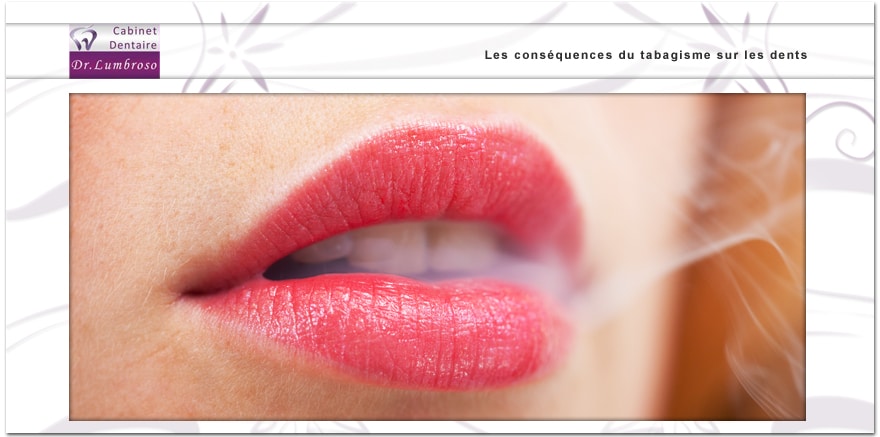
Everyone is aware of the serious health consequences of smoking, especially for the lungs and heart. But we sometimes forget that the teeth and mouth of smokers are also very exposed to the harmful effects of tobacco.
Almost everyone knows that smoking causes staining and discolouration of the teeth, yet the effects of smoking on oral health tend to be ignored or downplayed. However, your teeth, gums, tongue and lips are also at risk with every puff of a cigarette; and the consequences can be serious.
Gum disease and caries
Smoking promotes the formation of bacterial plaque in the mouth, which increases the risk of periodontal disease (tooth decay). In addition, nicotine has been shown to alter the vascularity of the gums, which reduces the gum's ability to defend and repair itself. As a result, the body will find it more difficult to fight gum infection effectively. Compared to non-smokers, gum disease progresses at a faster rate in smokers.
All of this explains why the success rate in implantology is lower in smokers (80% - 85% in smokers VS 97% success rate for non-smokers).
See our fact sheet on implants.
We also have more surgical complications in smokers, especially after extraction...
Also, a smoker is likely to have three times more caries due to the increase in plaque caused by smoking.
See our fact sheet on caries prevention.
Bad breath or halitosis
Tobacco and bad breath are closely linked. But it is mainly the increased bacterial proliferation that causes this halitosis.
Stained teeth
The tar and nicotine present in cigarettes leave yellow or brownish stains on the teeth which can become permanent by penetrating the small cracks in the tooth enamel after several years of smoking.
Most of these so-called extrinsic stains can be removed with the help of air polishing, which is a high-pressure spray of bicarbonate, salts and water that removes these deposits. All our treatment rooms are equipped with this equipment (see here).
Over the years, these discolorations eventually penetrate the interior of the tooth and can only be reduced by professional bleaching at the dental surgery.
Consult our sheet on dental bleaching
Oral cancer
Of all the oral diseases linked to smoking, oral cancers are certainly the most serious. They manifest themselves in several forms: cancer of the mouth, lips, tongue, palate, tonsils, gums and throat. The risk of oral cancer is 5 to 10 times higher in smokers. Mouth cancers affect 6,600 French people every year.
What solutions?
Of course, quitting smoking would ideally be the first thing to do, not only for the sake of your teeth but also and above all to preserve your health.
Alternatively, you can first visit your dentist for advice and care. Good oral hygiene on a daily basis is recommended. Brushing your teeth after each meal will help to eliminate as many bacteria as possible and to fight against dental plaque, which is the cause of caries and periodontitis.
Dr Michaël LUMBROSO
Implantologist - Periodontologist in Versailles
Current treatment techniques too often lead to tooth loss. Specialists stress the importance of a preventive model of minimally or non-invasive care.
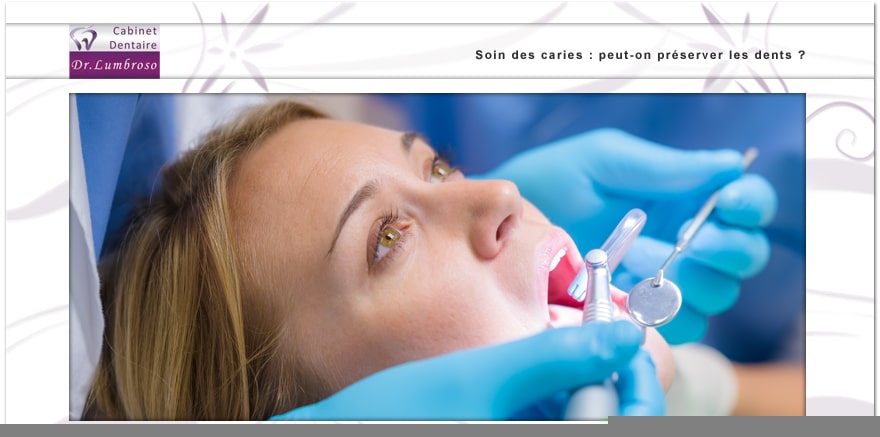
The FDI World Dental Federation has recently issued an alarming report on the oral disease of dental caries, a global scourge that continues to be endemic worldwide despite the knowledge of the disease and the resources available to the dental profession.
Faced with this situation, it is necessary to change the system of caries management, replacing the traditional curative model of dental care, based mainly on the achievement of dental fillings which too often lead to the loss of the tooth, by a less invasive model of care based on the preservation of dental tissue.
The dental surgeon should no longer limit himself to repairing teeth damaged by caries, but should assess the caries risk of each patient in advance and treat the disease with primary and secondary preventive measures : application of minimal dental care (sealing of dental grooves, remineralisation of the dental enamel by the application of agents, dental micro-preparation...), in addition to continuous monitoring of the patient throughout his life. By adopting a medicalised approach based on prevention and follow-up, patients, both children and adults, can be spared from cavities.
Thanks to the technological means available to practitioners, contemporary dentistry makes it possible to carry out mini-invasive or a minima care which remains as much or even more demanding than conventional care. In this case, the dental surgeon must intervene under painless local anaesthesia, by placing a rubber operating field on the tooth (the dam) and using binocular magnifying glasses or a dental microscope to be able to operate on the scale of the lesion of the dental enamel. In addition, the instrumentation for removing decayed tissue has been considerably diversified and improved, as have the burs, which have become miniaturised and in some cases are made of diamond or porcelain. The use of these abrasive diamond micro-bits on standard vibratory instruments makes it possible, for example, to remove the carious area extremely precisely without destroying the healthy tissue surrounding the lesion (this is known as sono-abrasion).
The practitioner can also use oral lasers, which are more suitable for treating soft tissues (gums, oral mucosa), but which can help him or her to complete or improve the treatment at the early stage of the carious lesion. For example, erbium lasers can be used for minimal caries removal, especially in the molar grooves. Caries treatment should be complemented with the use of dental composites, directly bonded and polymerised to the tooth to obtain a watertight filling that will prevent further penetration of cariogenic bacteria into the dental tissues.
In conclusion, these technological advances will only be of interest if the dental surgeon combines them with accurate and early diagnosis of caries and control of the risk factors. Taking these dimensions into account in a global approach will enable the carious lesion to be treated effectively while preserving the tooth, to the great benefit of patients.
Source : le figaro.fr
According to a recent study, nearly a third of French people brush their teeth only once a day, whereas brushing after each meal would be ideal. However, there is no shortage of brushes and oral health accessories on offer. In this article we explain how to find your way around.
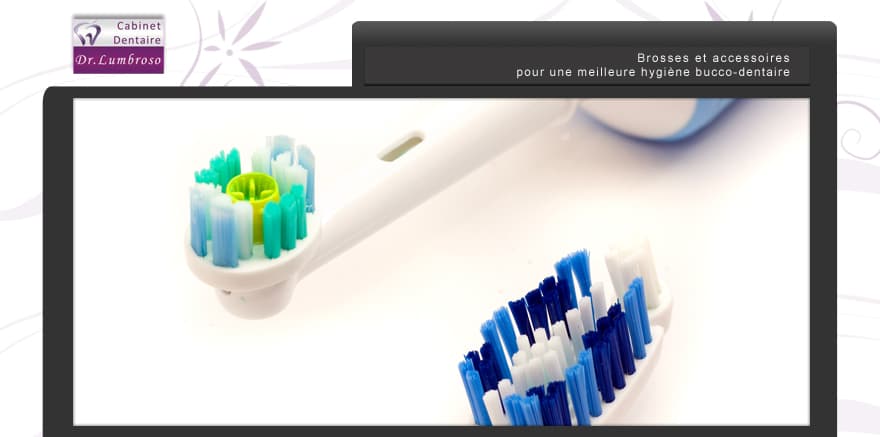
Toothbrushes: electric or manual?
With 11.5% of users in France, the electric toothbrush is not about to worry the traditional manual toothbrush, although it is becoming increasingly popular. Whether you choose one or the other, in both cases you should opt for models with a small head, which can reach hard-to-reach areas. If your gums are fragile, you should prefer a toothbrush with soft or extra soft bristles. In any case, the brushing time should last on average three minutes for an effective cleaning of all the dental areas. Remember that the right gesture takes precedence over everything else, especially the type of toothbrush you use. However, some studies tend to show that electric brushes are more effective, especially those that combine an alternating rotating movement with pulses. In any case, it seems to be accepted that the acquisition of an adapted gesture is easier with an electric brush than with a manual brush. So get your chargers!
The tongue scraper
Many of the manual toothbrushes you find in shops are now equipped with a tongue scraper on the back of the head. This little accessory is very effective, but is still underused. It can reduce the bacterial mass in the mouth by up to 60%, and thus combat the formation of plaque and bad breath. The tongue scraper should be used every time you brush your teeth for optimum effectiveness.
Dental floss and interdental brushes
In order to fight plaque effectively, you can combine the toothbrush and the tongue scraper with the use of dental floss or interdental brushes. These two accessories allow you to better clean the interdental spaces that the toothbrush cannot reach. It is important to know that these spaces are protective niches for bacteria! They represent the main risk of dental caries and gum disease. The use of brushes is essential for patients with a history of periodontitis (loosening of the gums) and for those with dental implants.
Contrary to what you might think, it is best to floss before brushing your teeth, in order to remove any bacteria that you may have dislodged with the floss!
Mouthwash
To complete your oral hygiene, you can use a mouthwash, preferably after brushing in the evening. However, although it can clean the mouth and give a fresh breath effect, it should never replace brushing your teeth. Please note that there are only a few mouthwashes suitable for daily use; therapeutic mouthwashes should not be used for more than 15 days. There are mouthwashes with essential oils suitable for regular use. Do not hesitate to ask your dentist or pharmacist for advice.
Fluoride, whitening, special sensitive teeth... there is a wide range of toothpaste on offer and it is often difficult to find your way around. We give you our advice to help you find the best toothpaste for your teeth.
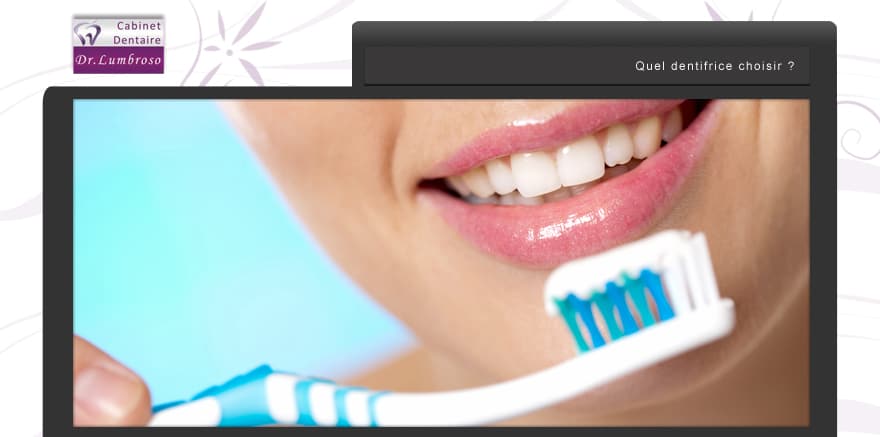
First of all, it should be remembered that toothpastes have only a limited action, they mainly play a role of "lowering surface tension", this is the "soap" effect! When brushing, the most important thing is the mechanical action of the bristles of the toothbrush, which enables the plaque to be removed.
Fluoride toothpaste
Le fluor est à la base de la protection et du renforcement de l’émail des dents. De plus il s’agit de l’un des meilleurs dispositifs de prévention face à la formation de la plaque dentaire et des caries. Attention toutefois à choisir un dentifrice fluoré adapté à votre âge. La dose de fluor présente dans les dentifrices pour enfants est en général plus faible que celle pour adultes. Prenez tout de même le soin de vérifier la quantité de fluor dans la composition.
Pour mieux choisir, voici les doses de fluor indiquées pour chaque tranche d’âges :
· De 0 à 3 ans : < 500 ppm (50 mg par 100g de pâte)
· De 3 à 6 ans : 500 ppm
· Au-delà de 6 ans : de 1.000 à 1.500 pm
· Chez l’adulte : jusqu’à 2.500 ppm
Regarder l’interview du Dr Michaël LUMBROSO sur la prévention ici.
Anti-plaque and anti-bacterial toothpastes
To combat periodontal disease (disease of the gums and the bone that supports the teeth), we recommend using a toothpaste containing chlorhexidine. This powerful antibacterial agent helps to clean the mouth, fight bacteria and reduce the occurrence of gingivitis.
The toothpaste that strengthens enamel
Enamel can become worn and demineralised over time, due to chemical aggression (acidic soft drinks, citrus fruits, etc.) or mechanical aggression (traumatic brushing, bruxism, etc.).
To protect the teeth against this effect, a toothpaste based on calcium peroxide, or based on a new protein that remineralizes the enamel: NOVAMINE® will remineralize and strengthen the enamel while eliminating the bacteria responsible for plaque. To promote its effectiveness, it is advisable to keep the toothpaste in the mouth for a certain period of time before rinsing, or not to rinse at all.
Toothpaste for sensitive teeth
Sensitive teeth are a condition that affects many people. It is characterised by brief but severe pain in the tooth when it comes into contact with hot or cold, sweet or sour foods, or when brushing. The main cause is the degradation of the tooth neck (where the tooth meets the gum), which extends to the gums that recede and expose the base of the tooth. To protect your teeth, you can opt for a low-abrasive gel containing fluorinol or permethol, which forms a protective layer by attaching to the surface of the dentin.
Whitening toothpaste
This type of toothpaste often has a higher abrasive power than conventional toothpaste, so that tooth discolouration can be removed more easily. However, whitening products do not whiten teeth, but only lighten them.
The disadvantage of this type of product is that it is aggressive to the teeth over time (especially to the enamel, dentine and neck). Ideally, it should be possible to alternate between a lightening product and a fluoride toothpaste, so as not to weaken and sensitise the teeth.
If you need more information on the different types of toothpaste, please ask your dentist for advice.
What is the connection between a cavity and joint inflammation? One might be tempted to answer: none. However, dental specialists have long been aware of the relationship between the two. And many sportsmen and women are unaware of the impact of oral health on their sporting activities.

The phenomenon was first observed in professional sports clubs (football, basketball, handball, rugby, etc.). Medical staff have indeed highlighted a link between the formation of cavities and certain injuries after observing that the convalescence was longer in players with damaged teeth . The bacteria that form cavities release toxins through the mouth wall into the bloodstream and attach themselves to inflammation, thereby delaying healing.
If you play sport regularly, it is advisable to avoid drinking too many fruity or energy drinks and ideally to replace them withpure water.
Because although these drinks provide the minerals, vitamins and energy needed for muscular effort, they are usually too acidic. And it is well known that the combination of Acidity + SUGAR is the main factor behind the proliferation of cariogenic bacteria and the formation of cavities.
In terms of prevention, it is recommended to brush your teeth three times a day, preferably after each meal, in order to eliminate bacteria and food debris and to reduce the acidity accumulated in the mouth.
Furthermore, the position of the teeth can also have an impact on the sportsman's muscles. Indeed, pathologies linked to dental occlusion (bad superposition of teeth, clenching, bruxism, etc.) can create asymmetrical muscular tensions and lead to muscular and tendinous pathologies such as pubalgia, which affects many footballers.
To remedy this, a dental surgeon can, after an occlusal assessment, carry out a re-balancing by fitting mandibular repositioning splints.
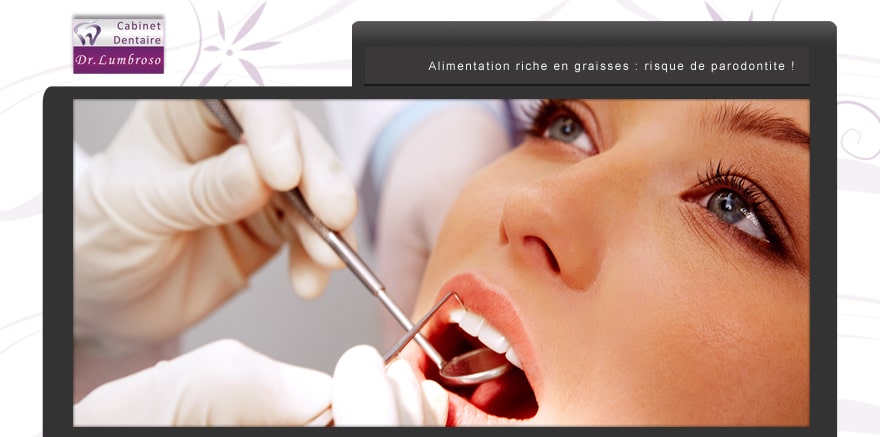
Researchers at Inserm (Institut national de la santé et de la recherche médicale) have just highlighted the link between a very fatty diet and periodontitis.
Researchers have just demonstrated, via their work published in the journal PloS One, that the modification of the bacterial flora in the mouth is at the origin of the inflammation of the periodontium, the supporting tissue of the teeth made up of the gum, cementum and alveolar bone. This inflammation, called periodontitis, can lead to loosening and even tooth loss if left untreated.
In recent years it has been shown that a high-fat diet changes the composition of the intestinal bacterial flora. This change favours the appearance and proliferation of pro-inflammatory bacteria that cause diabetes. These bacteria(Fusobacterium nucleatum, Prevotella intermedia) are also located in the mouth. The team of Rémy Burcelin and Dr. Vincent Blasco found that these same bacteria were at the origin of periodontal disease. Hence a common association between diabetes and periodontitis in patients.
Thus, these scientists were able to observe via tests carried out on laboratory mice that the local inflammation created by bacteria in the teeth, or in the intestine in the case of diabetes, is partly controlled by oestrogens, hormones present in men and especially in women, and which are thought to have a regulatory function on the local immune system. Hence the need to maintain a diverse flora in order to protect the tissues of the skin, mouth and intestine. This requires a varied diet, reasonable hygiene and moderate use of antibiotics. In order to prevent the risk of periodontitis, it is recommended to brush the teeth thoroughly at least twice a day and to consult a dentist once or twice a year. It should be noted that periodontal disease increases the risk of cardiovascular disease, lung disease and premature birth, and is responsible for 14,000 deaths per year in France.

According to the latest study by the French Union for Oral Health, a majority of elderly people in retirement homes have poor dental health. Hence the implementation of local and regional care and prevention programmes to remedy this problem.
According to figures from the UFSBD (Union française pour la santé bucco-dentaire), three out of four elderly people admitted to a retirement home are in a poor state of oral health. 44% have at least one decayed tooth; 40% have to have a painful tooth extracted; even more alarmingly, 10% need emergency treatment. This is due to neglect of preventive oral health care, as a majority have not visited a dentist in the last five years.
The observed deterioration in oral health has serious consequences for diet and health: malnutrition, risk of infection, general worsening of health, risk of heart disease, osteoporosis, etc.
Prevention remains one of the most effective weapons against the deterioration of people's oral health over the years. Daily hygiene, which involves brushing your teeth three times a day after each meal, is the first thing you should do to preserve your teeth. Toothpastes containing fluoride are recommended as they strengthen the enamel of your teeth. You can also use a mouthwash to cleanse your mouth and remove bad bacteria that could penetrate your tooth enamel.
Eating too much sugar can also threaten the health of your teeth. Avoid drinks and foods that are too sweet (sweets, candy), as their acidity reinforces the dangerous bacteria that cause cavities, such as Streptococcus mutans. In addition, a check-up at least once a year with your dentist is highly recommended. On this occasion, he or she can check the state of your oral health and carry out treatment if necessary (scaling, onset of decay, etc.)
By adopting these gestures and habits and applying them rigorously over the years, you will preserve your dental capital, which will save you a lot of trouble later on. Don't wait for dental pain to set in before consulting your dental surgeon!
Source: UFSBD
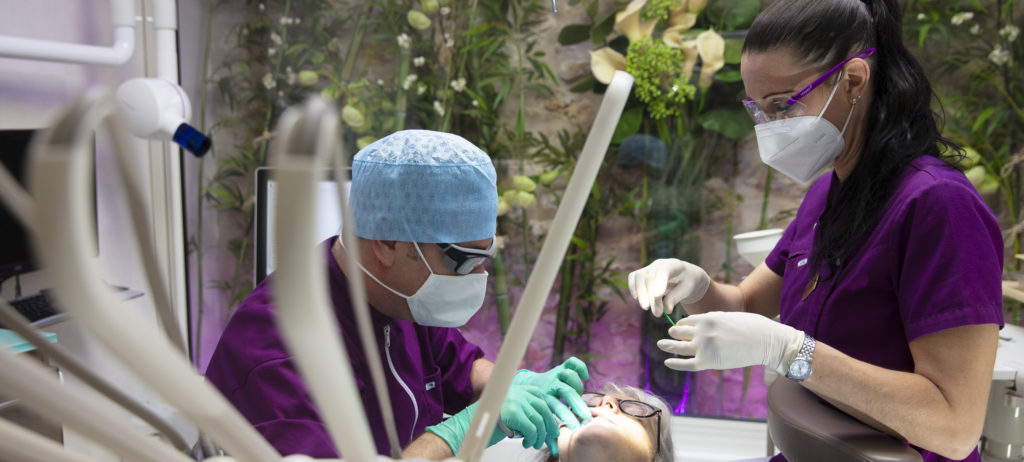
Afterreading this article on TF1 News, I found it interesting to reproduce it on our site.
Regular scaling would reduce the risk of heart attack.
By Véronique Buonomano , 14 November 2011 at 10:10 am , updated 14 November 2011 at 10:26 am
Regular teeth cleaning by a dentist could reduce the risk of heart attack and stroke, according to a study by Taiwanese cardiologists unveiled on Sunday in Orlando, US.
A bright smile, not only to seduce but to live longer? Regular scaling and cleaning of teeth could reduce the risk of heart attack and stroke by 24% and 23% respectively, compared to people who have never had dental work done. This is the finding of a study by Taiwanese cardiologists who met on Sunday in Orlando, USA, for the annual conference of the American Heart Association.
This study was conducted on 100,000 people, followed for seven years. Of the participants, more than 51,000 underwent at least one dental scaling. Doctors consider a tooth cleaning to be frequent if it is done at least twice or more in two years. None of the participants in this study had suffered a heart attack or stroke at the start of this research, the authors said. " The protection against cardiovascular disease and stroke was more pronounced in participants who had their teeth scaled at least once a year," says Dr. Emily Chen, a cardiologist at the Veterans General Hospital in Taipei, one of the lead authors of the research.
Bleeding gums increases heart risk.
Before this study, poor dental hygiene was already medically linked to increased cardiovascular risk. Regular cleaning and scaling of teeth appears to reduce the development of bacteria in the oral cavity that cause inflammation and can contribute to the development of cardiovascular disease, according to the researchers.
Another Swedish study involving nearly 8,000 participants, also presented in Orlando on Sunday, shows that gum disease is a good indicator of cardiovascular and stroke risk. People with fewer than 21 of the normal 32 teeth had a 69% increased risk of heart attack in this research compared with two who had the most teeth. Participants with the highest number of periodontal pockets, an infection of the gums around the tooth, had a 53% increased risk of cardiovascular disease compared to those with the fewest such infections. Participants with the fewest teeth had a 2.5-fold increase in the risk of heart failure. Finally, the study subjects with the most frequent gum bleeding had a 2.1-fold increase in the risk of stroke compared to those with the least. This research was mainly conducted by Dr Anders Holmlund, a dental surgeon.
By Véronique Buonomano on 14 November 2011 at 10:10
Notes : The consequences of gum disease discussed in this article are quite logical.
Bleeding gums (or Gingivitis), is a sign that the gums and supporting tissues of the tooth are becoming infected (Periodontitis).
This is an infectious disease and the bacteria that cause it can circulate throughout the body, which can affect our general health. Other links have been shown between gum disease and general health conditions. We know today that periodontitis favours the appearance of certain types of diabetes, is a risk factor for rheumatoid arthritis and cardiovascular diseases, and increases the risk of premature births, etc.
So let's take care of our gums, and don't hesitate to ask us questions!
